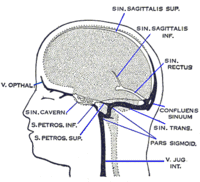
Photo from wikipedia
Purpose To report the rare presentation of orbital compartment syndrome secondary to formation of carotid cavernous fistula in the absence of trauma or surgery and demonstrate the role of emergent… Click to show full abstract
Purpose To report the rare presentation of orbital compartment syndrome secondary to formation of carotid cavernous fistula in the absence of trauma or surgery and demonstrate the role of emergent canthotomy/cantholysis as a vision saving procedure. Observations A 28-year-old African American female with obesity and migraines presented to the emergency department (ED) with the worst headache of her life after a severe episode of vomiting and dry heaving. Initial CT scan was negative for subarachnoid hemorrhage and patient was discharged. She re-presented to ED several days later with worsening proptosis and left eyelid edema and was discharged on oral antibiotics for presumed preseptal cellulitis after repeat CT scan. When seen by Ophthalmology in clinic, she was noted to have decreased vision, proptosis, decreased color perception, and double vision. She was noted to have orbital compartment syndrome requiring emergent canthotomy/cantholysis in the minor OR. She was sent back to ED for work-up, ultimately revealing a carotid cavernous fistula secondary to rupture of a carotid cavernous aneurysm. She was treated with several coil embolization procedures and ultimately her visual acuity rebounded to 20/20. Conclusions and Importance Orbital compartment syndrome may be a rare presentation of carotid cavernous fistula secondary to ruptured carotid cavernous aneurysm in the absence of trauma or surgery. Our case demonstrates the importance of properly assessing the cause of a red, edematous, proptosed eye in clinical setting and initiating an appropriate workup and treatment plan without delay.
Journal Title: American Journal of Ophthalmology Case Reports
Year Published: 2022
Link to full text (if available)
Share on Social Media: Sign Up to like & get
recommendations!